By Ian Sebire

 She is probably the least well known of all the ‘ships of state’ introduced in the 1960s. Longer than Sagafjord and Shalom, larger than Alexandr Pushkin, her relative anonymity is, indeed, a travesty. Proudly named after the great instigator of Portuguese exploration in the 14th and 15th centuries, the nation’s flagship was also their largest ever passenger liner, fully deserving her place in the pantheon of great 20th century passenger ships.
She is probably the least well known of all the ‘ships of state’ introduced in the 1960s. Longer than Sagafjord and Shalom, larger than Alexandr Pushkin, her relative anonymity is, indeed, a travesty. Proudly named after the great instigator of Portuguese exploration in the 14th and 15th centuries, the nation’s flagship was also their largest ever passenger liner, fully deserving her place in the pantheon of great 20th century passenger ships.
The ‘Infante’ or ‘IDH’ as the name was inevitably abbreviated, was ordered in December 1957 by Companhia Colonial de Navagação (CCN), to serve Portugal’s African territories in Angola and Mozambique. The builder of choice was the Cockerill Shipyard at Hoboken, near Antwerp, Belgium. They had completed a slightly smaller pair of sister ships in the early 1950s, for the company’s Central and South America service. The new design (devised by the owner’s in-house naval architects, headed by Taborda Ferreira, in tandem with Cockerill‘s own design team) showed a clear family resemblance to those aforementioned twins, Vera Cruz and Santa Maria.
On 29th April 1960, dressed overall in signal flags and festooned with garlands around her bow, yard number 814 was named Infante Dom Henrique by Maria Theresa Scares de Fonseca, wife of the CCN president. To the cheers of spectators in the yard and others lining the opposite bank, she slid down the ways and into the waters of the Schelde. Nine months later, on 22nd January 1961, as IDH neared completion at her fitting out basin, company and country became the unwanted focus of the world’s media spotlight. As Santa Maria sailed through the calm waters of the Caribbean, armed rebels seized the ship, in protest at Antonio de Oliveira Salazar’s government. Tragically one of the ship’s officers was shot in the ensuing struggle and initially the ship made for Angola. Subsequently she diverted to Recife in Brazil, after negotiators persuaded the maritime hijackers to release the complement of terrified, innocent passengers. In the first days of February, amidst rumours of a blockade by Portuguese and Brazilian warships, the rebels surrendered.
CCN’s problems were far from over. The same month that Santa Maria was thankfully returned intact, in frigid conditions far removed from the tropics she would serve, the Infante was eased away from her fitting out berth and taken downstream, into the inhospitable North Sea. As her Westinghouse turbines were cranked up to their 22,000 shp limit, builder and owner alike became progressively concerned at the new ship’s performance. Speed and stability were not in question but the source of their anxiety had plagued generations of steamships ever since the screw propeller had been introduced, vibration had occurred. Physical trials became metaphorical trials, and as the Infante headed back to her berth, engineers were already analysing the data, to devise a solution.
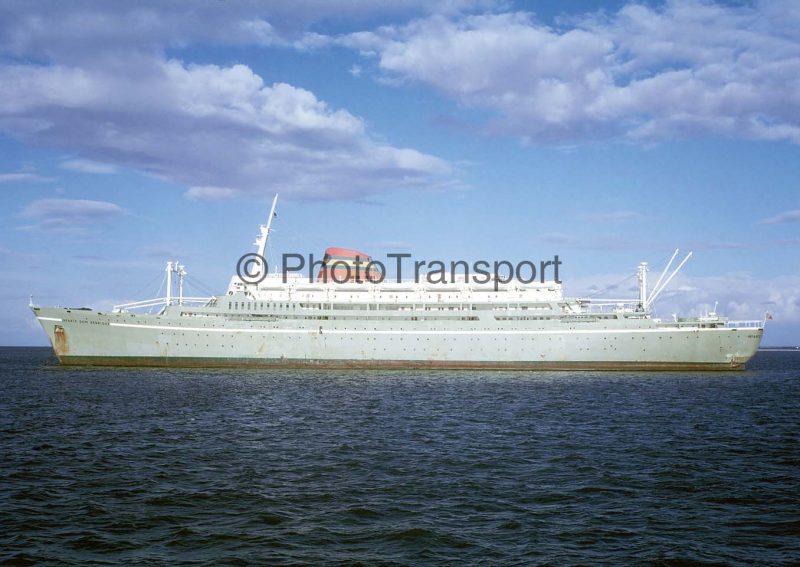
After much head scratching and a delay of several months, the cause was traced to the design of IDH’s two propellers. New four bladed screws were ordered to replace the original ones. To the relief of all concerned the remedy worked, Infante dom Henrique was accepted by her owners in late September, and sailed from Belgium to Lisbon.
Externally she presented a very handsome profile, featuring a tall, sharply raked mast, and a broad, low, rounded funnel. This latter feature incorporated a large grille forward, and a smaller vented area aft (similar to the Italian Line’s Andrea Doria and Cristoro Columbo and to her Messageries Maritimes rivals on the East Africa trade). Neatly terraced aft decks and a stepped, curved, forward superstructure, were set upon a hull featuring a sturdy, raked, bow and rounded, spoon style stern. Perhaps the only blemish on an otherwise elegant silhouette were the two sets of vertical kingposts (one forward, one aft) and associated booms, which cluttered the otherwise svelte appearance. The new ship’s most noteworthy feature was more illusory than physical. Defying convention and in a bid to emphasise their flagship’s modern feel, the board of Companhia Colonial de Navagação decided on a quite unique livery for the ‘Infante’. Demarcation between grey/green hull and white superstructure was taken two decks higher than usual, incorporating A (also known as promenade) deck. Certainly unique, the bold effect was slightly subdued by a white sheer band around the hull and the ship’s name in contrasting black letters.
With provisioning completed and excitement mounting, IDH departed Lisbon and steamed down the Tagus on 4th October 1961, at the commencement of her maiden voyage. Those first passengers were ensconced on a vessel of quite startling modernity, in contrast to the interiors of her more conservative, lavishly wood panelled predecessors.
Nominally she was a two class ship, First and Tourist. However Tourist class was further subdivided between Tourist A (slightly larger, generally amidships cabins, some with their own facilities) and Tourist B (cabins generally aft above the screws with communal bathrooms requiring a scurry down corridors). Segregation of the classes was through a combination of vertical and horizontal divisions. Games and Boat deck were exclusively given over to First Class with the latter featuring 38 suites, all with private facilities and picture windows. Farthest forward were two large deluxe suites with views over the bows. These backed onto the ship’s chapel whose entrance was in a vestibule at the top of the impressive three deck high First Class lobby. Aft on boat deck was the First Class outdoor swimming pool and adjacent bar.
A Deck (also referred to as Promenade Deck) housed the majority of public rooms for both classes. These were flanked by an open promenade, although the forward sections were glazed. Forward and central were the first class smoking room and lounge, separated by a vestibule and stairwell. A large statue of ’Henry the Navigator’ adorned this impressive hallway. Retained in her later career the statue was often mistaken for her pseudonym ’Vasco da Gama’. Further aft was the Tourist class smoking room and bar with access to an outdoor bar, the Tourist class swimming pool and sun deck. This deck also housed the children’s rooms for both classes and the library.
B Deck also had an open promenade encircling all but the forward end. The majority of this deck comprised first class and Tourist A cabins. All 58 first class cabins included private facilities and a window looking out onto the promenade. Furthest aft was the large Tourist class lounge and bar.
Down in the hull the first full length deck was C Deck, which included the embarkation points (First class forward, Tourist aft), main stairwell lobbies with associated purser and information desks for each class. The lobbies also acted as entrance vestibule for the respective restaurants, divided by a central galley. Aft of the Tourist class restaurant was the ship’s hospital.
The remaining passenger decks (D and E) were given over to Tourist class (Tourist A forward and amidships, Tourist B aft) cabins for between two and eight passengers.
All public rooms were decorated in refreshingly light colours with recessed lighting and modern, angular furniture. Rooms were decorated with an eclectic mix of artwork, including sculpture and friezes from Portuguese artists.
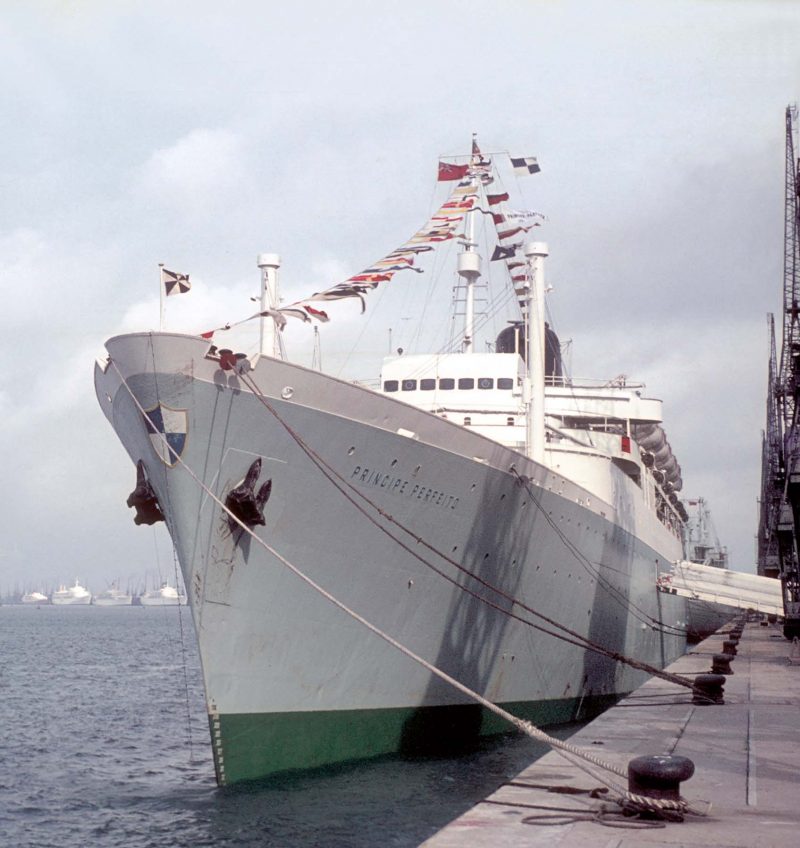
The passenger list for that first voyage comprised the full spectrum of society and was representative of her clientele throughout her time on the East Africa service. The machinery of colonial government, civil servants, police, clergy and military personnel (though always in civilian dress) mixed with business men, tourists and emigrants. Also masquerading as passengers was a covert team of PIDE officers, the Portuguese secret police, assigned by the Government to thwart any repeat of the Santa Maria hijack. There were berths for 156 in First Class, 384 in Tourist Class A and 478 in Tourist Class B all served by a crew of 318. Once in the Atlantic, IDH set course for Funchal, capital of Madeira. From Funchal she steamed South, rounding the West African coast before calling at Luanda and Lobito in troubled Angola. At the time this was still a Portuguese territory, regarded more as a province than a colony but armed factions were already seeking independence and the country rapidly descended into civil war. Reinforcements were sent out from Portugal aboard Vera Cruz, which spent most of the 1960’s in this troop ship role. From Lobito the Infante continued south to the tip of the continent and Cape Town, nestling under the brooding presence of Table Mountain. After calling at this iconic city she skirted the South African coast before making her next landfall at Laurenço Marques (now the capital Maputo) on Mozambique’s southern extreme. The final port of call and African terminus was Beira, further up the coast and notorious for its humid climate and surrounding swamps. Having discharged her final passengers and cargo, a fresh complement was embarked for the return home, calling at the same ports in reverse order. Forty five days after that maiden departure she was back again, tethered to the Lisbon shoreline.
Infante dom Henrique and her crew proved admirably up to the task, providing a reliable service, in tandem with Companie Nacionel’s Principe Perfeito. This Tyne built liner of slightly smaller dimensions was also completed in 1961. From an operational perspective the Infante was a very successful and happy vessel. Her career with CCN was generally incident free, no collisions, fires or significant events or delays, quite an achievement given the notoriously tempestuous seas she encountered, especially off South Africa’s east coast where the confluence of Atlantic, Indian and Arctic oceans was the breeding ground of rogue waves and tempests. Contrary to the general trend of the decade, the human element proved equally reliable. There were none of the strikes, the great blight of shipping throughout the 196’s and early 1970s, the crew were genuinely proud of their role, to be serving on the national flagship.
Initially at least the Infante was also a profitable vessel for her owners. Her main sea going competitors were Lloyd Triestino’s 11,400 ton Africa and Europe (though these ships sailed via Suez) and Union Castle’s aging Rhodesia Castle and Kenya Castle. Nevertheless as the decade went on passenger numbers dwindled, in the face of increased competition from the skies and colonial retrenchment. One obvious option was to send IDH on more cruises but with the exception of a special voyage to commemorate the opening of the new Tagus suspension bridge in 1966, there were none until the 1970s.
Independence is rarely a smooth process for either the departing power or the newly liberated state. This transition was particularly painful in Angola and Mozambique. In truth, as the new decade dawned, Portugal itself was in transition. The long standing, autocratic Prime Minister Antonio de Oliviera Salazar, was replaced due to ill-health in 1968. Salazar unambiguously sought the retention of Portugal’s overseas territories and as previously mentioned, throughout the 1960s , reinforcements were sent from the homeland to retake territory and restate Portugal’s administration. His replacement Marcello Caetano faced a daunting task, with a nation in turmoil and the broader international community (rather hypocritically?) critical of Portugal‘s reticence to grant independence.
Against this background of instability Infante Dom Henrique continued to ply her trade, but schedules now showed her sailing from Lisbon only as far as the two Angolan ports, with a call each way at Las Palmas in the Canary Islands. For two months (December 1971 to January 1972) she cruised out of Durban on charter to Pelltours. Seven months later she undertook the longest cruise of her CCN career to Brazil. With the withdrawal of Vera Cruz and more particularly Santa Maria, responsibility for CCN’s annual New Year cruise to Madeira fell to Infante dom Henrique from 1973. The following year, the three principle Portuguese shipping companies were merged to form Cia Portugesa Transportes Maritimos. IDH was now part of a consolidated fleet including Principe Portofierto and the beautiful Funchal. She adopted a somewhat garish funnel livery with a vibrant orange/red replacing the previous buff colour, blue bands replacing the original green, which now sandwiched a broad yellow band rather than white. The hull and superstructure were now all white, after all CCN’s modernistic intentions were now largely redundant. Like all the principle shipping companies of the time the new company was facing a double blow of decreasing revenues (airline competition was now impacting on all routes, including those to Africa) and escalating costs (oil prices quadrupled in October 1973). Factor in the impending withdrawal from Angola and Mozambique and inevitably the Infante’s days were numbered.
In fact Portugal itself was on the brink of change. Senior elements of the country’s army became progressively disillusioned with the colonial wars and on 25 April 1974 staged a coup d’etat, ousting the government. This ’revolution of flowers’ resulted in government by military Junta, which allowed left wing politicians, banned by the previous regime, to return. The next couple of years were characterised by economic and political instability at home, and negotiations regarding colonial withdrawal abroad. On 25 June and 10 November 1975 Mozambique and Angola were respectively granted independence. Infante Dom Henrique and Principe Perfeito were superfluous.
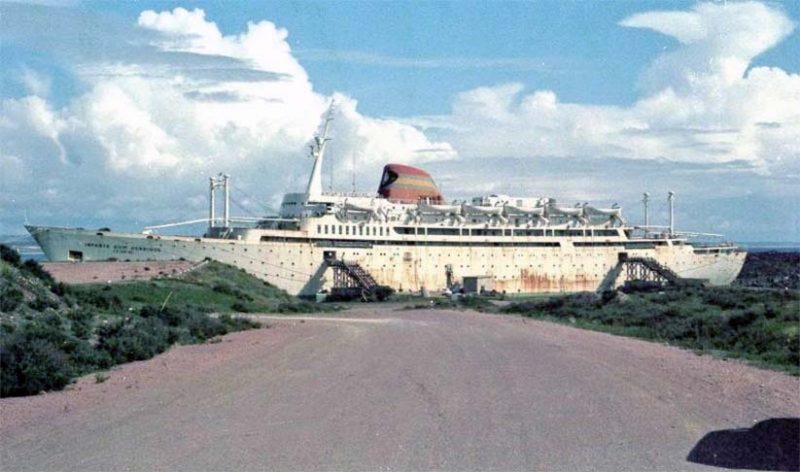

Arriving back at Lisbon on 3rd January 1976 after a final ’New Year’ cruise to Madeira, IDH was destored and laid up. She seemed an ideal candidate for conversion to cruising but no prospective purchaser came forward. After eighteen months of inactivity she was sold to Gabinete da Area de Sines (GAS), a government backed venture to redevelop land near the village of Sines, south of Lisbon, into a large commercial and industrial complex. Infante dom Henrique’s dubious role would initially be to provide accommodation for construction workers, then on completion of the complex to act as a floating hotel. Allegedly $10 million was invested in transforming the ship for her new role but most of this appeared to be spent on creating an encircled lagoon. With her propellers removed the Infante was towed into her new mooring and the entrance blocked by a breakwater of rock and earth.
The Sines development never materialised. Marooned in her landlocked cell, the former Portuguese flagship stood forlornly in an otherwise apocalyptic landscape. The surrounding acres had been cleared and flattened in preparation but only mounds of redundant materials provided any evidence of the intended development. Musty and rust scarred, with peeling paint and faded funnel colours, the Infante languished and deteriorated for nine long years. Some first class accommodation was kept available for curious visitors but she was never viable as a hotel and was largely abandoned. It seemed inevitable that at some point apathy would turn to action and she would be sold for scrap. Ironically perhaps, the main reason she avoided a premature end on the beaches of India, was her incarceration. Scrapping in situ was not feasible and removing the enclosing breakwater was too costly.
GEORGE POTAMIANOS
Ultimately redemption came from a shipping magnate with the vision, tenacity and financial backing to make the seemingly impossible real. Comparisons with the fate of the former French Line flagship are inevitable. For France and Knut Kloster read Infante dom Henrique and George Potamianos. This Lisbon based Greek tycoon acquired the ship and spent $50 million converting her into a modern cruise ship. Having been released from her Sines penitentiary, IDH arrived at Lisbon in February 1988, for preliminary work. From Lisbon she was towed to a yard near Piraeus for major internal and external refurbishment. The first priority was to enlarge and add en suite bathrooms in cramped, former Tourist class accommodation. The lower decks were gutted and new plumbing and partitioning installed.
The external changes enhanced an already beautiful ship. Redundant kingposts, booms and associated equipment were removed both fore and aft. A solitary, central crane was installed forward. A small mainmast was installed aft of the funnel, complementing the tall existing radar mast and mimicking it’s shape and rake whilst the existing pools included expanded lido areas. The classically balanced profile was complemented by a new all white livery, with narrow blue sheer band at the top of the hull. The funnel was repainted yellow with two blue bands. Great thought went into a new name for the ship. Potamianos’ choice, Vasco da Gama, perpetuated the ship’s historical theme, honouring once more a great Portuguese explorer. It also had a broader appeal than Infante dom Henrique, being both more widely known and less cumbersome to pronounce for north European and American tongues.
Vasco da Gama’s first employment was on charter to Neckermann Reisen. The German tour operator had utilised the Soviet cruise ship Maxim Gorkiy (formerly the German Atlantic Hamburg) for almost a decade but was looking for a less costly option when the charter came up for renewal. The Neckermann charter seemed fated from the start. From her first cruise, in November 1988, the ship was plagued by a variety of plumbing and mechanical gremlins, including faulty air conditioning and blocked toilets. Worse was to come. On 5th December 1988 as she lay at her Lisbon pier, a fire broke out in the engine room. Although ultimately brought under control, the damage was extensive and she had to be towed to the Lloyd Werft yard at Bremerhaven for repairs.
At the end of December she left Germany under her own steam bound for Genoa and the start of the longest cruise of her entire career. On 7th January 1989 she sailed from Italy, on her first and only circumnavigation. Taking a westerly course she called (amongst others) at New York, Auckland and Sydney. There were maiden crossings of the North Atlantic and Pacific Oceans and transits of both Panama and Suez canals. Regrettably her reputation was not enhanced when a boiler breakdown in June 1989 necessitated another impromptu repair at Lloyd Werft. Earning the unfortunate and rather caustic sobriquet ‘Fiasco da Gama’, passenger loads diminished. Prior to the second planned world cruise Neckermann abruptly cancelled the charter.
Having invested so heavily in her renovation Potamianos’ aspirations appeared to be in tatters. In fact Vasco da Gama’s fortunes were about to take a positive turn. Following the withdrawal of Neckermann a new venture, Ambassador Cruises, took up the charter. After a refit at Lisbon, which included repainting the funnel white and adding the company logo (a stylised ship’s wheel made out of six blue A’s in a circle on a yellow disc), Vasco da Gama sailed in early 1990 to Limassol, Cyprus for a series of Eastern Mediterranean cruises to Egypt and the Holy Land.
SEAWIND CRUISE LINE

At about this time, in June 1990, another Greek ex-pat, Anastasias (known as ‘Taki’) Kyriakides, formed a company called Seawind Cruise Line. His idea was inspired and quite unique, to charter a moderately sized vessel and operate a year round, weekly cruise itinerary in the Southern Caribbean, from the popular resort island of Aruba. Cruises could be combined with a break in one of the island‘s fashionable hotels. No other cruise ships were home ported in the area and crucially the ports of call were too far south to be visited by the new mega ships, then sailing weekly from Miami and Fort Lauderdale. In late 1990 Kyriakides and his small team started to publicise and market the cruises, though the fledgling company was lacking an important ingredient, a ship. Initially he made an arrangement to charter Aegean Dolphin, the recently rebuilt Zim Line ferry Narcis but when this fell through the whole operation appeared doomed. Salvation for both cruise line and ship was the imminent availability of Vasco da Gama. After flying to Greece and finding the former liner perfect for his intended service Kyriakides agreed a five year charter. Seawind Cruises redoubled their promotion of the new venture. One key element was pricing, and the company worked hard with charter airlines to offer cruises (including the three hour flight from Miami to Aruba) that were competitive with their Florida rivals.
At the end of July 1991 Vasco da Gama finished a series of Brazilian coastal cruises and sailed for Oranjestad. Preparations were hectic to get the ship ready for her 3rd August maiden voyage. Company president and stewards rubbed shoulders, lugging furniture and supplies around the ship. A container from Miami including stewards uniforms and linen napkins never materialised (paper napkins were used throughout that first sailing). The entertainers dresses were impounded by Customs and only released at the eleventh hour thanks to Kyriakides’ personal intervention. Perhaps most amusingly a final inspection of the dining rooms revealed that sugar sachets were labelled with rival Premier Cruise line’s motif, the supplier for both companies having mixed up their delivery. A legal dispute meant that the intention to change the ship’s name to Seawind Crown was put on hold, she therefore sailed on that maiden voyage as Vasco da Gama. In due course she displayed both the Portuguese name and her adopted name, on the bow.
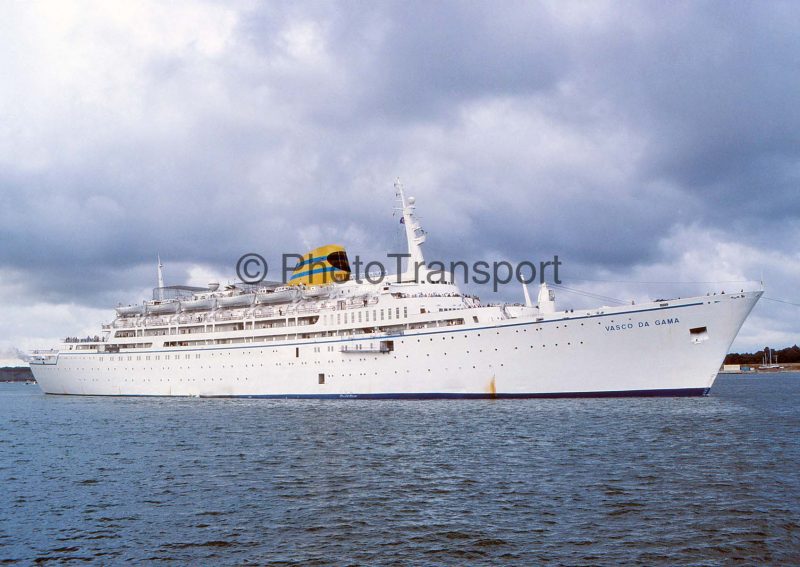
Despite these and many other temporary hiccoughs the business flourished. Vasco da Gama’s old world charm, coupled with the warmth and attentiveness of her Portuguese and Greek officers, Portuguese cabin staff and European stewards and deck crew, proved a winning formula. She won plaudits for the quality of her ‘international’ style cuisine and entertainment. There was a small casino but perhaps symbolic of the simplicity and uniqueness of those early years was a Saturday night ritual, whereby couples could renew their wedding vows in the presence of the Captain, in the ship’s chapel. She attracted quite a cosmopolitan clientele, the majority were from North America but there was also a sizable South American and North European contingent, amongst her 624 passenger load.
The ports of call also proved to be a major draw, devoid of the gleaming white behemoths disgorging their thousands of passengers.
Each Sunday evening she cast off from Oranjestad and called at Willemstad on the neighbouring island of Curacao, also a former Dutch colony, on the Monday morning. Initially Tuesday was a leisurely day at sea before arriving at St George, Grenada on the Wednesday and the very British island of Barbados on Thursday, where European passengers joined. On Friday there was a final landfall at Castries, St Lucia before turning south, steaming through the ‘South Seas of the Caribbean’, as the marketing material emphasised, before turn around day at Aruba on Sunday.
With a 90% occupancy rate Seawind Crown’s success in this niche market prompted the company to buy the ship outright at the end of her charter period. Realising the need to remain competitive and retain her loyal following, a second, alternative itinerary was introduced, calling at Antigua, Barbados, Guadeloupe and Dominica. This could also be combined with the original for extended 14 night cruises.
PREMIER CRUISES
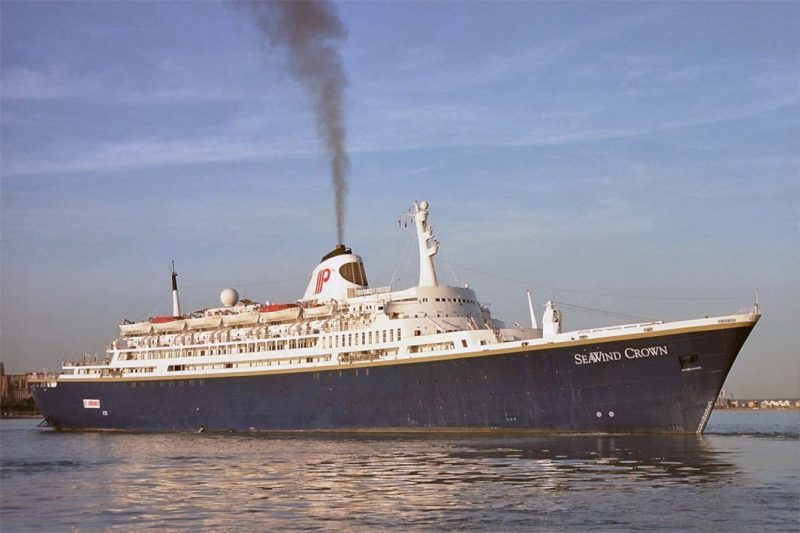
In 1997 Cruise Holdings Ltd., owner of Premier Cruise Line took a majority shareholding in Seawind Cruises, together with rival Dolphin Cruises operators of Seawind Crown contemporaries Island Breeze (originally Transvaal Castle), Dolphin IV (originally Zim Line’s Zion), and Sea Breeze (originally Federico C). In hindsight the Premier takeover was the beginning of the end. Initially Seawind and Dolphin Cruise Lines retained their autonomy. Seawind Crown continued to sail from Aruba and incorporated an additional port of call, La Guaira, Venezuela on the itinerary. Despite the occasional scathing internet review her popularity remained generally undiminished.
Premier’s parent company, Cruise Holdings Inc. was lauded as the saviour of assorted veteran liners. Doubtless well intentioned they may have saved their bodies but took liberties with their souls. Seawind Crown escaped the indignity of becoming one of the scarlet hulled Big Red Boats, nevertheless a new, deep blue hull with broad gold band and a deep blue funnel livery was adopted. It ill-suited her. Premier’s meddling management then decided to move Seawind Crown to a new service in the Autumn of 1999, sailing along Mexico’s Pacific coast from Puerto Vallarta. It was a disaster. Advanced bookings were so poor that the whole concept was quietly abandoned after just a couple of cruises.
Instead the 38 year old liner found a final flourish close to her spiritual home. She was chartered to Pullmantur, one of Spain’s largest package tour operators, for year round, weekly cruises in the Western Mediterranean sailing out of Barcelona. So positive were the results that Pullmantur ultimately set up its own cruise line in 2002. Alas Seawind Crown’s part in this success was short lived. On 17th September 2000 after docking at Barcelona she was arrested on behalf of creditors of the now bankrupt Premier Cruises.
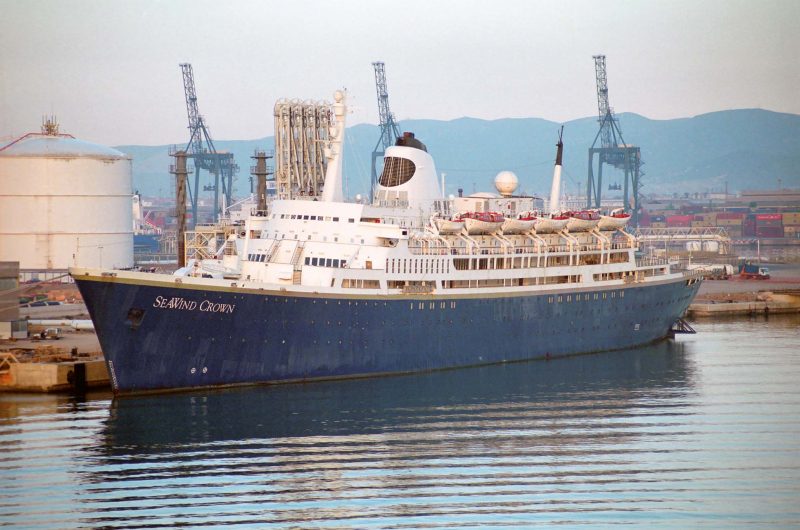
Moored in the shadow of the futuristic World Trade Centre, Seawind Crown was occupied by disgruntled crewmembers seeking recompense from liquidator’s Price Waterhouse Coopers or Pullmantur for their unpaid wages. Surviving on food donated by local seaman’s charities, they held out for six months but it was a futile gesture. Despite their best efforts the liquidators were unable to find a buyer and ultimately ownership passed to the local port authority.
As if to emphasise their control of the unwanted squatter, Seawind Crown was renamed Barcelona and ushered off to an unused pier in the outer harbour. In 2002 her funnel was capped and only essential power maintained. For more than a year she lay dormant, listing slightly to port. Then news came that she had been sold to Indian ship breakers and under her own power Barcelona left her namesake port of refuge on 28th December 2003. Contrary to expectation the former Infante dom Henrique did not head for the killing fields of Alang but having transitted the Suez canal sailed across the Indian Ocean and was next traced to Singapore. Her delivery crew revealed the destination was in fact Guangzhou and the initial intention was to re-activate the ship for overnight gambling cruises. Fortunately for such a proud and historically significant ship she was spared such an ignominious fate. Instead she was sold to the local Pan-Yu shipyard for scrapping. By the end of 2004 she was gone.

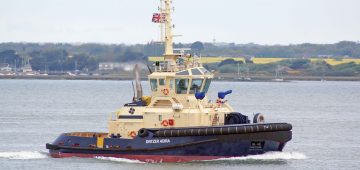



Comments
Sorry, comments are closed for this item